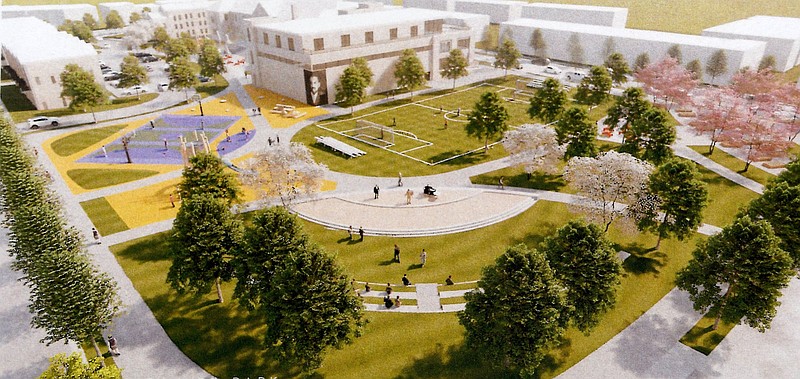Almost five years ago, May 31, 2017, we made a note to ourselves about Chattanooga's Westside: "There is something wrong - just wrong - with starving Chattanooga's Westside until the community so shrivels up that developers can swoop in and get some of our city's most valuable real estate for nothing."
You know the Westside we were thinking about: College Hill Courts, Boynton Tower, Jaycee Tower, Gateway Tower and Dogwood Manor, the old James A. Henry Elementary School that now houses Head Start and the newly infamous Grove Street where on Sept. 25 seven women were shot - two fatally - in the aftermath of a block party.
Altogether, the Westside is one of Chattanooga's oldest neighborhoods and still is home to about 1,500 families - mostly with very low incomes and many of whom live in public housing properties owned by the Chattanooga Housing Authority.
"Valuable real estate?" you ask doubtfully. Most certainly! It may be virtually cut off from most of our existing downtown Chattanooga by Interstate 27, but it sits on the highest hill left in downtown, with commanding views of the Tennessee River, the new and growing Moccasin Bend park and the mountains across the river.
To the community's north, on the other side of Martin Luther King Boulevard sits BlueCross BlueShield and another swath of new offices and condos. On its river-facing side, the hill falls away and backs up to the new and glitzy Cameron Harbor and a newer section of the Tennessee Riverwalk. To its south stretches more riverfront property encompassing the 115-acre former Alstom factory site now slated to anchor The Bend and expected to the city's biggest multimillion-dollar riverfront revitalization project since Ross's Landing was remade more than decade ago.
What's been the holdup for the transformation of this most valuable property? The fact that it largely is a public housing site and thus is tied up in federal funding, federal red tape and a lot of both good and bad community and CHA history.
For Westside's future, and for the future of Chattanooga's growth and improvement in the coming decade, this holdup development is both a blessing and an opportunity - if we make it so.
You may recall the debacle that unspooled when two other aging public housing properties were torn down here - one for urban renewal in the Alton Park community and another to open industrial property to bring jobs to the depressed East Chattanooga area.
The then-Housing Authority leadership moved and evicted the residents of Spencer J. McCallie Homes, telling them HUD's $35 million HOPE VI grant would eventually provide new housing for 535 families to return. But CHA didn't even track the departing residents, let alone have any real plan to bring them back. Instead, 275 rentals and 44 homes for ownership were built on the tract that once was the city's largest public housing property.
The same basically happened when the Harriet Tubman Homes were razed at different times between 2005 and 2014. CHA in 2012 evicted remaining residents and put the site up for sale. When an out-of-town-buyer sale fell through, the city bought the property in 2014 and completed the demolition. In 2019, Nippon Paint announced plans for a 150-employee plant there.
This time in Westside, CHA wants to do right by the more than 500 families who live in the eight-decades-old College Hill Courts and structurally flawed Gateway Tower - altogether about a third of the families in Westside. To that end, CHA, the city and the Chattanooga Design Studio have developed a blueprint known as the Westside Evolves Transformation Plan, according to CHA Executive Director Betsy McCright.
"The Housing Authority [pre McCright's leadership] has had a history of kind of bulldozing and moving people off properties We did not want this process to be like that, so we approached the city and the design studio to work with us on the process," she said.
CHA and Design Studio workers have been talking with residents in many meetings and events - even during the pandemic - since September 2020 to get ideas, input and work up the plan to renew or replace these homes without displacing either the feel of the neighborhood or the people who live there. Mayor Tim Kelly, in the plan's preface, notes that with College Hill Court's 81-year history, it's been home to more than five generations of our residents, making it one of the most historic neighborhoods in the city.
The community as a whole is 87% Black with 49% of residents living at or below poverty level. About 22% have children and nearly 31% are disabled. Half do not have reliable internet access, and 66% receive food stamps (compared to 18% across the city).
All of this - especially with the no-displacement aspiration - means rebuilding public housing that looks and feels compatible with all the new and ritzy development that will be growing up right beside it in every direction.
"The plan recognizes that the heart of this neighborhood is its residents," according to the executive summary.
This very impressive plan is as it should be. It also, we hope and insist, must be followed. If so, it will banish our fearful 2017 concern for Westside. And it should go a long way toward Kelly's stated objective of fostering one Chattanooga, not two - one doing fine, and the other neglected.
The devil, as they say, will be in the details.
